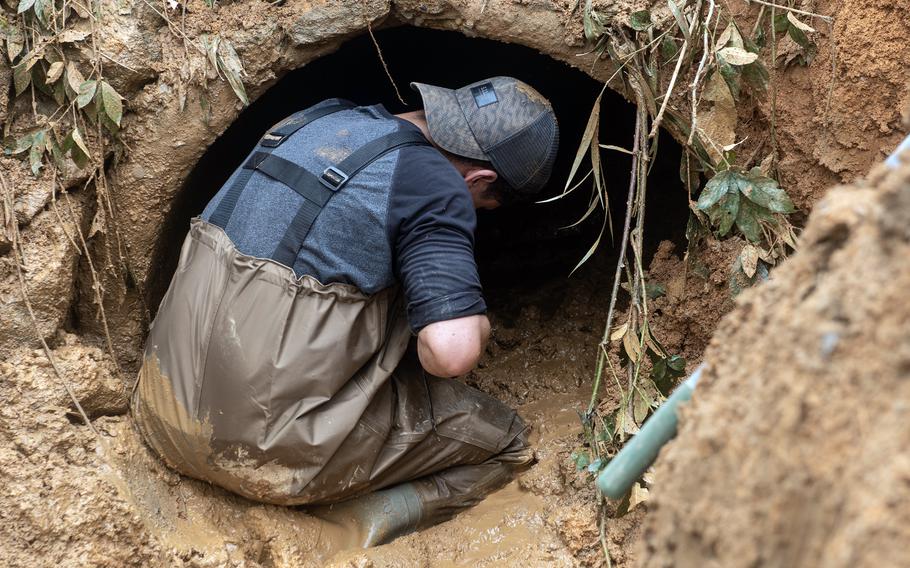
U.S. Army Sgt. Jathanuel Sealy-Marks, of the Defense POW/MIA Accounting Agency, clears a drainage pipe used for screening soil during a recovery mission in Vietnam on March 26, 2024. (Ariel Owings/U.S. Air Force)
The Defense Department agency tasked with accounting for the missing in action from America’s wars identified 172 service members in the just-ended fiscal year, a slight uptick from previous years but still short of the effort’s annual goal.
The Defense POW/MIA Accounting Agency identified 135 service members missing from World War II, 33 from the Korean War and four from the Vietnam War in the fiscal year ending Sept. 30, according to DPAA spokesman Sean Everette.
That is up from the 158 missing service members identified during the previous fiscal year and 166 from the year before that.
About 81,000 Americans are still missing from World War II and subsequent conflicts, with almost 90% of those from WWII.
A provision of the 2010 Defense Authorization Act requires the Defense Department to fund the recovery of MIA remains at a level that ensures capacity to account for at least 200 individuals each year.
Over the years, that figure “has translated into a goal” for the agency, Col. Matt Brannen, DPAA deputy director of operations, told Stars and Stripes in February.
The agency’s ambitions for fiscal year 2024 were hampered by gridlock in Congress over defense spending that left DPAA, along with the rest of DOD, operating at the previous year’s funding levels for almost six months.
Jack McManus, national president of Vietnam Veterans of America, has repeatedly urged Congress to step up funding for recovering MIA remains, particularly from the Vietnam War.
“Today, the families of 1,577 Americans still listed as MIA from Southeast Asia wait patiently for answers regarding their unaccounted-for loved ones,” McManus testified March 14 before a joint meeting of the House and Senate Veterans Affairs Committees.
At the time of the hearing, Congress had not passed the defense spending bill that included about $196 million for the DPAA.
“Timely and consistent funding of DPAA is an effective way for Congress to ensure that those families receive the fate-clarifying information and closure that they deserve,” he said.
Despite the funding impasse, DPAA did mark some milestones in the past fiscal year.
Last month, the agency made its 700th identification of service members who went missing during the Korean War. DPAA director Kelly McKeague described the accounting of Army Cpl. Billie Driver as “an incredible milestone” in a Sept. 16 news release.
Everette provided a list on Wednesday of other DPAA accomplishments of the past year:
• The remains of 91 unknowns were disinterred from 14 American Battle Monuments Commission cemeteries in the Europe-Mediterranean region, which represented the single highest total of unknowns disinterred in that region during any fiscal year.
• The number of unknowns disinterred by DPAA and its predecessor organizations surpassed 500 in the Europe-Mediterranean region.
• In the Indo-Pacific region, 69 unknowns from the Manila American Cemetery and Memorial in the Philippines were disinterred.
• Indo-Pacific personnel conducted 28 investigation and recovery field missions.
• Missions to Vietnam and Papua New Guinea succeeded in recovering bones and other evidence.
DPAA also continued its collaboration with outside organizations, such as Project Recover and the University of Wisconsin’s MIA Recovery and Identification Project.
An outside team continued to search for a B-24H bomber that crashed in January 1944 on the Isle of Morgo, Italy. Another outside organization searched for remains from a B-24 submerged in 300-foot-deep waters off Bisevo Island near Vis, Croatia.
In the Pacific, partner-led missions in the Philippines and Vanuatu led to the underwater recovery of remains.
DPAA and its partners operated in 46 countries during the past fiscal year, Everette said.